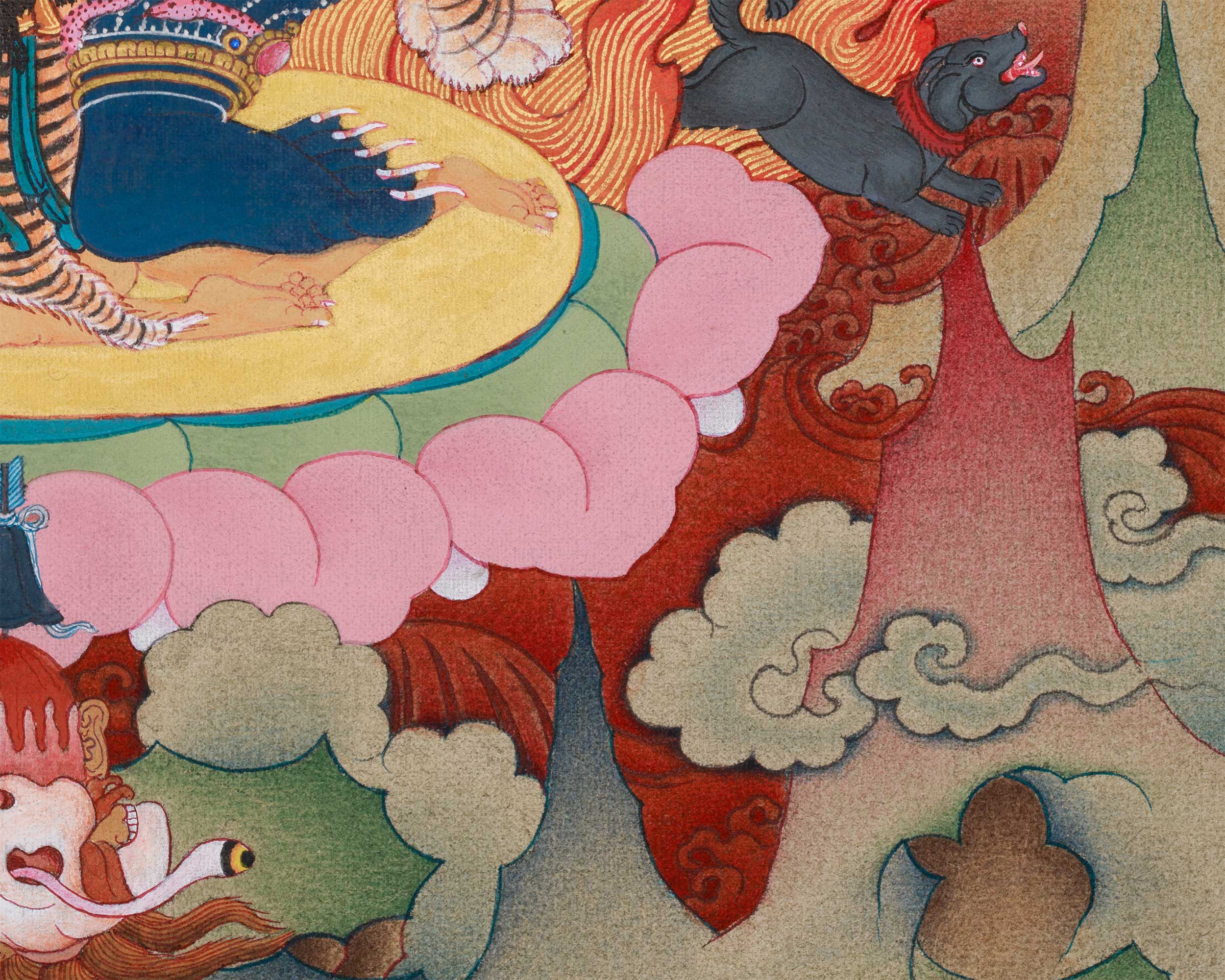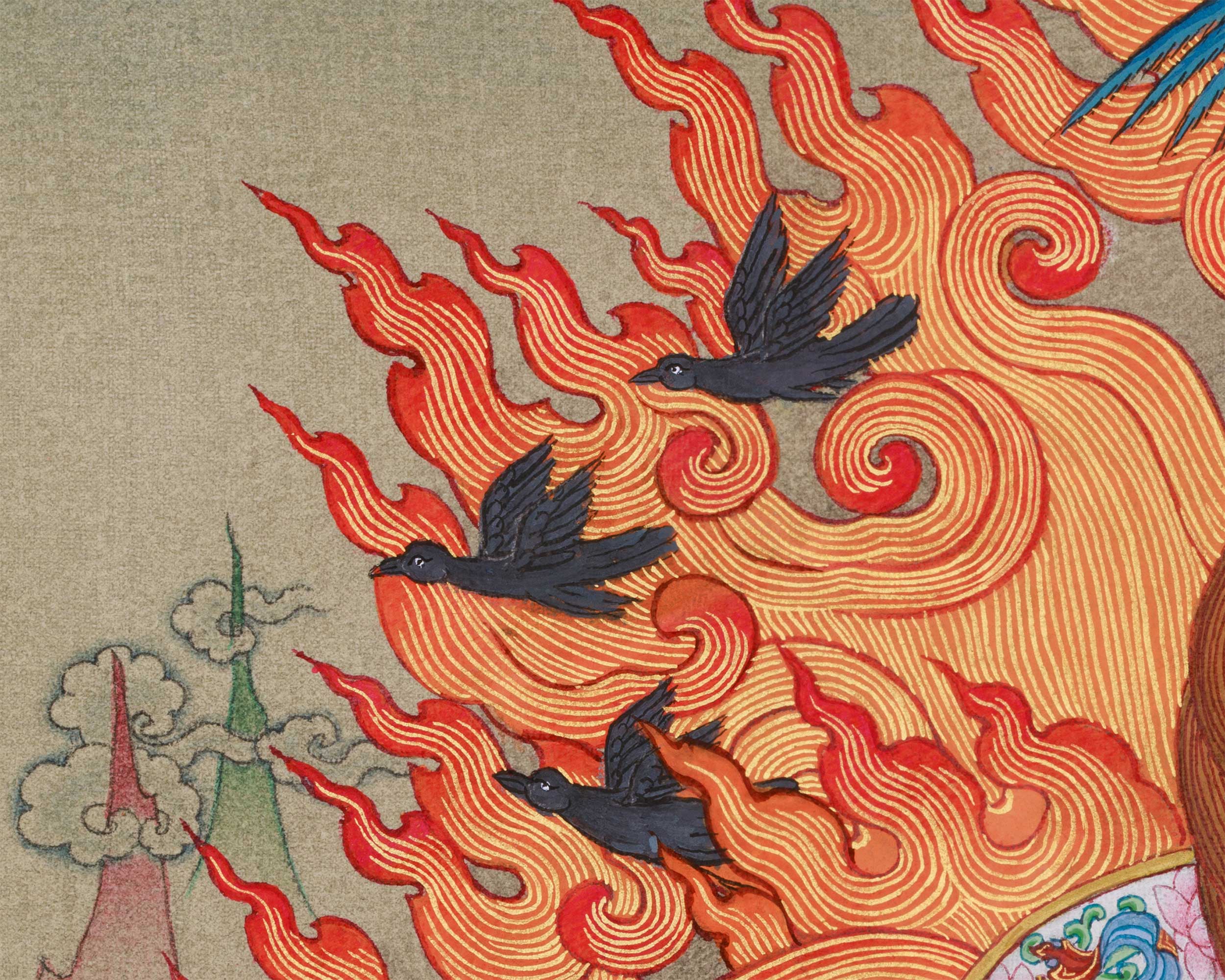Few Tibetan thangkas radiate such raw power as the Two-Armed Panjaranata Mahākāla, a principal protector of the Sakya school. In the painting above, the deity sits amid a blazing storm of primordial fire, his fierce gaze cutting through illusion, while the world around him trembles with symbolic life.
Click here to View this Sakya Mahakala Thangka in Details
Look closely and you will notice an entourage not of gods, but of animals—crows, a black dog, and jackal-spirits who inhabit the burning charnel grounds. These beings are more than background details: they are spirit-attendants, representations of enlightened activity, and signs of the protector’s dominion over all realms of existence.
This article explores the meaning behind each of these animal companions and what they tell us about the Protector’s role in Tibetan Buddhism.
1. The Black Crows: Messengers of Mahākāla’s Commands
In the upper left of the thangka, a group of three black crows swoops and circles through the sky. These birds appear frequently in Sakya depictions of Mahākāla and are known traditionally as “the black messengers” (nag po’i pho nya).
What They Symbolize
-
Mahākāla’s emissaries who carry messages across realms
-
Omen-bearers, whose movements can reveal warnings or blessings
-
Masters of the air element, linking Mahākāla to the vast open sky
-
The rapid, unobstructed activity of the protector
In tantric context, crows are not regarded as ordinary animals, but as spirit-carriers, capable of bridging the visible and invisible worlds. When appearing in thangkas, they signal that Mahākāla’s presence extends far beyond the central figure.
2. The Black Dog: Tracker and Guardian of the Burning Ground
To the right of the protector sits a black dog, ears raised, alert and ready to leap. The black dog is one of Mahākāla’s most trusted companions.
Symbolic Roles
-
A subdued spirit turned into a loyal guardian
-
Represents tracking of karmic hindrances and obstacles
-
Embodies the earth element—stability, grounding, and loyalty
-
Guardian of the charnel ground threshold
In some ritual texts, this dog is described as the “hound of the blazing cemetery,” a spirit once wild and destructive, now bound by oath to protect practitioners.
3. The Jackal-Spirits: Howlers of the Charnel Grounds
At the bottom left of the thangka, hiding near rocks and flames, is a jackal-like creature, and another appears in motion near the lower center, dancing with a bell. These are charnel-ground jackals, primal beings associated with death, fire, and transformation.
What They Represent
-
Fearlessness in the face of death
-
The power to devour impurities and obstacles
-
The fire and wind elements, embodied in their swift, unpredictable forms
-
Subdued wild spirits who now serve the Dharma
In many wrathful Buddhist depictions, jackals act as symbolic scavengers, consuming the remnants of ignorance and negativity—what ordinary beings fear, they purify.
Their presence reinforces the theme that Mahākāla’s realm is a cremation ground, where transformation is swift and absolute.
The Charnel Ground Environment
Surrounding the deity are stylized mountains, smoke clouds, and the swirling forms of cremation-ground fires. This landscape is the stage of liberation, a tantric symbol of impermanence, where Mahākāla reigns supreme.
Everything here—animals, winds, flames, and spirits—is under the protector’s enlightened command.
Conclusion
This Thangka is a masterful portrayal of Sakya Panjaranata Mahākāla in his full wrathful majesty. The crows, dog, jackals, and sky-sprites weaving around him are not random additions but powerful symbols of his enlightened activity.
They remind us that:
Everything—beast, spirit, wind, flame, and shadow—can become an expression of awakened protection when transformed by wisdom and compassion.




